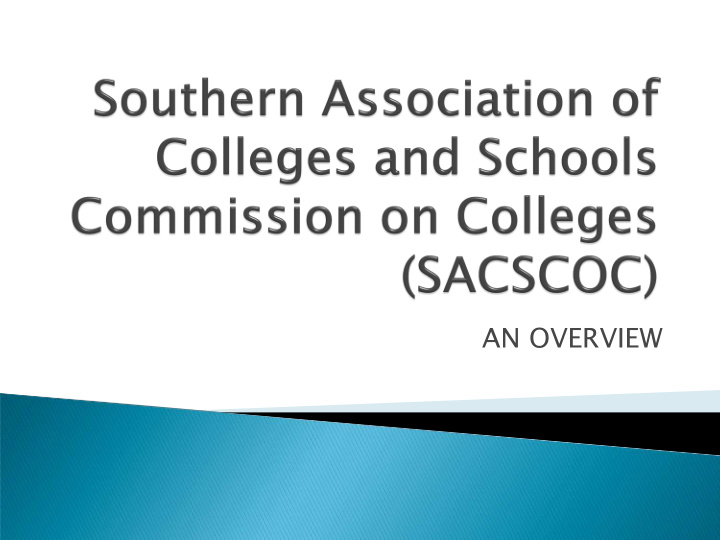



AN OVERVIEW
Understanding the basics of accreditation Understanding the role of the institution’s board in the accreditation process Discussion of current issues (institutional and national) in higher education today
National Agencies Accredit institutions of higher education that have a single focus irrespective of location Regional Agencies Accredit all aspects of an institution of higher education in specific regions Specialized or Professional Agencies Accredit programs within institutions
Improve Quality throughout the institution Assure the public that institutions meet established standards Serve as a “gate-keeper” for federal financial aid
Review by U.S. Department of Education based on recognition standards Recommendation by DOE to National Advisory Committee on Institutional Quality and Integrity (NACIQI) (Appointed group of educators and public members) NACIQI makes recommendation to recognize or not recognize an accrediting agency to U.S. Secretary of Education
The requirements and standards which institutions must meet to become members and remain members Developed by committees or task forces consisting of representatives of member institutions Can be changed only by vote of College Delegate Assembly
Principle of Integrity Core Requirements (CR) ◦ Governance, Administrative Structure, Mission, Curriculum, Learning Resources, Student Support Services, Financial and Physical Resources, Faculty, Evaluation and Planning, Quality Enhancement Plan Comprehensive Standards (CS) ◦ Same as above but in further detail Federal Requirements (FR) ◦ Student achievement, complaints, publication of policies, student authentication, credit hour, state authorization
Policy olicy-making b body dy Hi Hire, e, E Evaluate an and, when en n nec ecessary, F Fire t the e CEO EO Fid iducia iary re responsibil ilit ity f for th or the in instit itutio ion
Leadership Orientation Compliance Certification Off-Site Committee Review Focused Report On-Site Committee Review QEP Non-Compliance Issues Selected Issues for US DOE C&R Committee Review Executive Council Review Board Approval
Accreditation Reaffirmed Reaffirmed with a Monitoring Report Reaffirmed with Follow-up to be included in Fifth-Year Interim Report Placed on Warning (6 or 12 months) Placed on Probation (6 or 12 months) Dropped from Membership---this is the only action that can be appealed for (1) failure of SACSCOC Board to follow procedures or (2) decision was arbitrary and unreasonable
Co Complementary b but ut se separate dut duties [Clear and appropriate distinction, in writing & in practice, between policy-making function of board & responsibility of administration & faculty to implement policy.] (CS 3.2.6)
Is the he legal al bo body dy wi with h aut authority ove ver insti titu tution on. Mi Mini nimum of five ve me members. Not ot con ontr trol olled by a minor ority ty of of boa oard members s or by organizations/ ns/int nter erest ests s separa rate fro rom it it. (CR 2.2)
Respo ponsibi bility & y & authority o y of faculty [Policies on the responsibility and authority of faculty in governance and academic matters.] (CR 2.2 & CS 3.7.5)
Ac Acad ademic f free eedom [Ensures adequate procedures for safeguarding and protecting academic freedom.] (CS 3.7.4)
Prote rotect t in insti tituti tion f from u rom undue in influ luence [Maintain freedom from undue influence from political, religious, or other external bodies and protects the institution from such influence.] (CS 3.2.4)
Con onflict ict of of in inte terest [Presiding officer of the board & a majority of the other voting members of the board are free of any contractual, employment, or personal or familial financial interest in the institution.] (CR 2.2)
Sel Select ct an and ev eval aluate the e CEO [The governing board is responsible for the selection and the periodic evaluation of the chief executive officer.] (CS 3.2.1)
Board rd m member d r dismis issal [Policy whereby board members can be dismissed only for appropriate reasons and by a fair process.] (CS 3.2.5)
Ensuring a adequ quate f financial r resources a and d stab tabili lity ty (CR 2.2 ; CR 2.11.1; CS 3.10.1) tatements (CR Prov rovide a appropriate te f fin inancia ial l state 2.11.1; CS 3.10.3; FR 4.7)
1. College Completion 2. College Readiness (Developmental Ed.) 3. Funding (Performance Based, Mergers, etc.) 4. Campus Safety & Security 5. Alternate Methods of Learning (Dist. Ed., CBE, badges, liberal arts vs. occupational ed., etc.) 6. Politics 7. Cost and Student Debt 8. Transfer of Credits 9. Board Behavior and Responsibilities 10.New Leadership Recruitment & Training
Dr. Belle S. Wheelan, President SACS Commission on Colleges bwheelan@sacscoc.org 404.679.4512 www.sacscoc.org
Recommend
More recommend